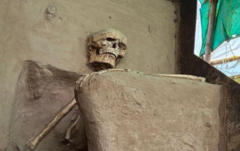An ancient skeleton, estimated to be 1,000 years old and uncovered in Vadnagar, India, continues to await a permanent home in a museum, remaining exposed in a makeshift shelter for over six years. The significant find was made by Archaeologist Abhijit Ambekar in 2019, who noticed a human skull while excavating in Gujarat. As his team delved deeper, they uncovered the remarkably preserved remains positioned in a cross-legged, meditative pose—a finding reminiscent of similar archaeological discoveries at just three other sites across India.
Riddled with bureaucratic challenges, the skeleton remains in limbo as local officials debate jurisdiction over its future. While Gujarat's government initially intended for various artifacts, including around 9,000 items excavated from Vadnagar between 2016 and 2022, to be displayed in local museums, the skeleton has not made it to its intended destination yet. This delay is attributed to claims by the state government that the skeleton is still under the care of the Archaeological Survey of India (ASI).
Ambekar emphasizes that the skeleton, likely from the historically significant Solanki period (940 to 1300 CE), holds immense value for understanding life in ancient India. He noted its unique posture, with one arm resting on its lap and the other raised in the air. Despite the skeleton's archaeological importance, red tape seems to prevent its secure placement.
Currently sheltered by a tarpaulin a short distance from a newly inaugurated Archaeological Experiential Museum, which houses over 5,000 artifacts representing Vadnagar's 2,500-year history, the skeleton still lacks an official resting place. Local residents, who often bring family and friends to view the remains, express frustration over the lack of protection and prompt housing.
The museum, celebrating the rich heritage of Vadnagar, cannot showcase the actual skeleton, despite featuring a prominent photo of it. Vadnagar itself, known as the birthplace of Prime Minister Narendra Modi, has a culturally rich history, with archaeological digs revealing ancient structures and artefacts dating back over two millennia.
Ambekar shared that DNA analysis has shown the skeleton belonged to a local man in his forties, with further studies required to elucidate dietary habits and lifestyle. Additionally, the find could provide insights into the practice of "samadhi burials" among Hindus, wherein revered individuals are buried rather than cremated.
The intricate excavation process spanned two months, utilizing specialized tools to ensure the skeleton was preserved. The entire operation of moving the rare find took six days, involving careful extraction of soil and treatment with chemicals to prevent decay.
Ultimately, Ambekar hopes the skeleton will find a museum home with climate control to safeguard it soon. Local citizens echo this sentiment, lamenting the neglect of such a significant archaeological artefact: “What is the point of building a museum if the most unique antiquity is left outside under a plastic roof?” argued resident Jesang Thakor, illustrating the community's pride and concern for their ancient legacy.




















